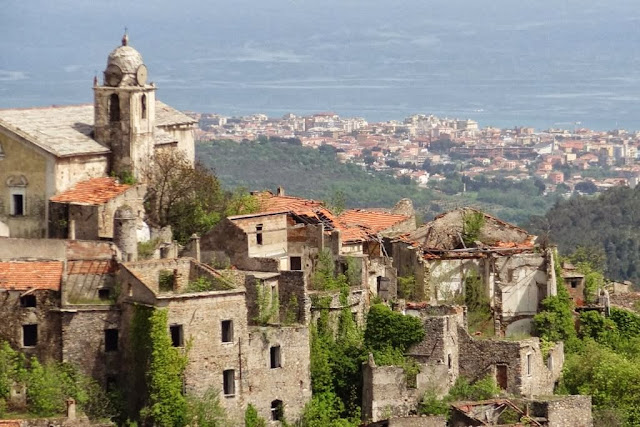Castelvecchio
di Rocca Barbena is another medieval village
with an old castle on a hilltop we happened to visit in the Savona province of Liguria
on our Italian holiday in late April. There was a parking lot for visitors up by
the road so we left the car there and climbed down to the village.
It wasn’t exactly a ghost village (see
my previous post here) but it very much felt like that. The only people we saw
were someone sunbathing on a rooftop terrace, a mother returning from an errand
of some sort and a couple in their fifties necking in the park-like square overlooking the valley.
(They must have been travellers too to choose such an open location for their
cooing.)
It seemed there weren’t any services
in the historical centre of the village. We did see a sign here and there
indicating there would be a shop or a restaurant behind a door or around a
corner but they were all not only closed by completely lifeless.
This village made me think about the
randomness of most everything. Some haphazard acts may determine so many things
around us, including fame and popularity of places. In this hectic time and age
when we can be online practically nonstop – and many of us are – information
on anything is constantly at our reach. But as we do not have the time or energy
to concentrate on practically anything properly but rely on the judgement of others some random happenings may define even
the survival of gorgeous little villages such as this one.
A popular travel writer might wander
into the village and ‘find’ it. A celebrity might end up there and start singing
its praises. One place will make it to the travel guides and another one,
equally spectacular and equally unique, just happens to be left unmentioned. So
it may remain unnoticed by the general public and may therefore be destined to
wither away.
I had no idea coincidences had
shaped also the fate of this village in recent decades. I have now learned that
the accidental arrival of some Scandinavians greatly contributed to its
subsequent revival after the damage caused by a heavy landslide in (again) 1953. A few
Swedes arrived in the 1970s and then a few Danes. They fell in love with the Neva
valley and started to restore buildings in the village from ruins. Later “a Genovese
antiquarian” restored a country house for himself, bringing with him his
sisters with their families and also some of his friends, a group of artists and restorers. I have understood also the feudal castle built in the 11th century by the Marquis of Clavesana has now been restored as a private residence.
This sounds like a legend but even if it were I
don’t mind. What’s important is that the lovely old village I regarded as a
faded one and felt sorry for is fairly alive and well even though its flourishing
is only seasonal. We just happened to be trying to find something to eat out of
season. It would probably have been different only a few weeks later. And yes,
we did see a fifth person when we finally noticed a restaurant door that wasn’t locked. The owner handed us two cold
beers and we had a look at the local newspaper while waiting for him to fetch a
couple of baguette panini from
next door, his home presumably.
 |
| I spotted some B&B potential also in this village. |
I’d love to see beautiful historical
villages like this bloom all year round but you can’t have everything. With a
population of much less than 200, you must be happy you have at least the holiday season
to depend on.
In fact, Castelvecchio di Rocca Barbena will surely continue to receive many visitors as it has been accepted to The most beautiful villages in Italy (I borghi più belli d’Italia), an association promoting small Italian villages of strong artistic and historical interest. Furthermore, the Touring Club Italiano has awarded it the Orange flag (Bandiera arancione), which is a recognition for sustainable tourism with excellent service and a welcoming atmosphere. On second thought, wasn’t that exactly what we experienced in the empty little taverna?
In fact, Castelvecchio di Rocca Barbena will surely continue to receive many visitors as it has been accepted to The most beautiful villages in Italy (I borghi più belli d’Italia), an association promoting small Italian villages of strong artistic and historical interest. Furthermore, the Touring Club Italiano has awarded it the Orange flag (Bandiera arancione), which is a recognition for sustainable tourism with excellent service and a welcoming atmosphere. On second thought, wasn’t that exactly what we experienced in the empty little taverna?




















































